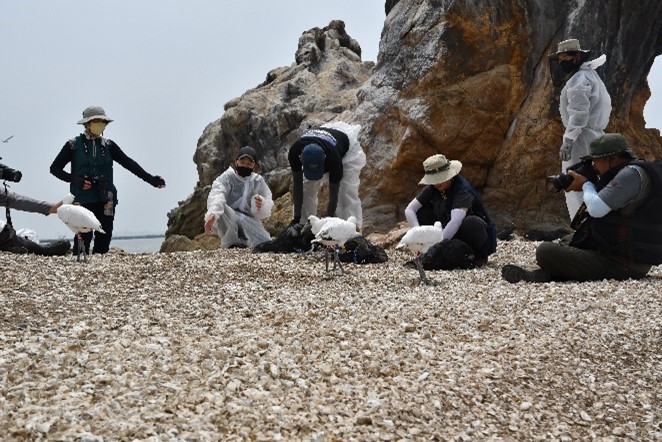"The Regular Monitoring of Migratory Waterbirds in Songdo Tidal Flat (Ramsar Site)"was coordinated by EAAFP Secretariat and sponsored by Incheon City Government. Twenty two surveys were conducted from June 2021 to May 2022 at the Songdo Tidal Flat Flyway Network Site (FNS), which is also a Ramsar Site, and its adjacent areas. A total of 223 (accumulated number) participated in it. A local NGO, "Black-faced Spoonbill and Friends" (BfS & Friends) and the BFS NGO Network participated in the process.
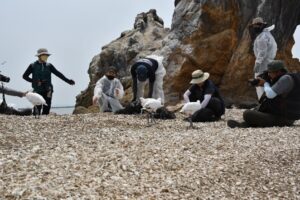
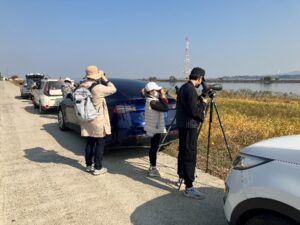
Action for waterbirds during the monitoring © BfS & Friends
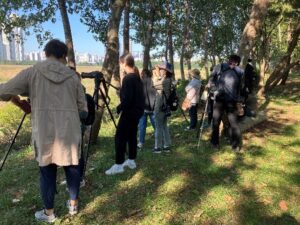
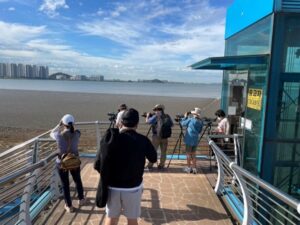
Action for waterbirds during the monitoring © BfS & Friends
During the survey period from June 2021 to May 2022, 87 species and 29,300 individuals (the sum of the maximum number of each species) were recorded at the target sites.
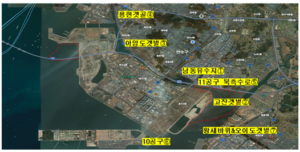
Survey Sites: (1) Namdong Reservoir, (2) Gojan Tidal Flat (Songdo Tidal Flat FNS), (3) Aam Island Tidal Flat, (4) Yonghyeon Tidal Channel, (5) Northern waterway of Area 11, (6) Area 10, and (7) Hwasae Rock and Oi Island Tidal Flat; The red line represents the Songdo Tidal Flat Ramsar Site (FNS). © BfS & Friends
This indicates that Songdo Tidal Flat Ramsar Site has been utilized as a habitat for various migratory waterbirds. However, we found population fluctuation of some species, e.g. Dunlin, during the monitoring of the Songdo Tidal Flat in 2022.
We assumed that the reasons for the decrease in shorebirds were (1) that Songdo Reclaimed Area 10 had been filled and dried up, which led to a loss of roosting site for shorebirds; and (2) that there was more frequent recreational fishing around the site, imposing disturbance to the roosting birds. The loss of roosting site at high tide caused by the Waterfront Space project also caused the decrease in population.
It is recommended that the remaining adjacent alternative habitats at the Songdo Tidal Flat should prohibit human access to protect the habitat and migratory waterbirds.
The site will regain its past condition favorable for waterbirds at the Songdo Tidal Flat FNS only if its alternative habitats would be designated and managed to sustain bird population as well as public awareness is raised.
Download and read the report [here].
Written by Mr. Heungbeom Oh from Black-faced Spoonbill and Friends (spgw100@naver.com);
Translated by Ms. Yunjeong Choi from EAAFP Secretariat
2021.06 ~ 2022.05 송도갯벌 철새이동경로 네트워크 서식지에서의 이동성 물새 정기조사
「송도갯벌(람사르습지) 저어새 등 이동성물새 정기조사」는 EAAFP가 주관하고 인천시의 후원으로 진행되었다. 송도갯벌 철새이동경로 네트워크 서식지(람사르 습지이기도 함)과 그 일원에서 2021년 6월부터 2022년 5월 기간에 총 조사 22회 했고, 참가자는 누적 합계로 223명이며, ‘저어새와 친구들’ 및 ‘저어새 NGO 네트워크’에서 주도하였다.
해당 기간 동안 관찰된 종수는 총 87종이고, 관찰된 개체수는 29,300 개체(각 종의 최대 수 합산)였다.
송도갯벌(람사르습지)은 다양한 이동성 물새들의 서식지로 활용이 되고 있음을 확인할 수 있었다. 하지만 매년 송도갯벌(람사르 습지)를 모니터링을 하고 있음에도 불구하고 올해처럼 급격한 변화를 체감한 것은 처음이었다.
기존 조사에서 도요물떼새 등 철새들이 이동을 하는 3월과 10월에 생태지표 지수가 상승하는 것을 확인을 할 수 있었는데, 올해에는 민물도요를 비롯한 도요물떼새들의 개체수 급감이 확인되었고, 그 중 가장 큰 차이를 보인 종은 민물도요이며, 이러한 현상은 도요과 전체에서 관찰되었다. 개체수 감소는 예상범위 내의 사건이었으나, 그 진행 속도는 예상치를 웃돌았다.
도요물떼새들의 감소 원인으로 보이는 것은 주된 서식지인 송도 10공구가 매립 및 내륙화한 것과 람사르 습지 내 낚시가 횡행하는 것 두 가지이다. 또한 만조 시 휴식지로 활용되는 공간이 친수공간사업으로 개방됨에 따라 휴식지가 없어진 점도 개체수 감소의 원인으로 추정된다.
지금 송도갯벌(람사르 습지)은 사람으로부터 간섭이 제한된 대체서식지가 절대적으로 필요한 상황이다.
대체서식지 조성을 통한 개체들의 안정과 시민인식증진을 통한 보호노력이 병행되어야 예전의 람사르 습지로 돌아갈 것으로 보인다.
[링크]를 통해 보고서를 다운로드 받고 읽어보세요.
저어새와 친구들 오흥범 팀장(spgw100@naver.com) 작성
EAAFP 사무국 최윤정 프로그램 연구원 한영 번역

